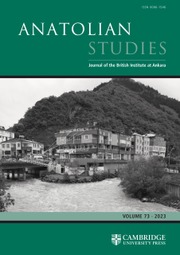No CrossRef data available.
Article contents
Imag[in]ing Hartapu: Reconsidering the rise of an Iron Age kingdom
Published online by Cambridge University Press: 28 August 2025
Abstract
Since the discovery of the TÜRKMEN-KARAHÖYÜK 1 inscription in 2019, Iron Age Anatolian scholarship has been energised by the appearance of a hitherto unknown kingdom in the Konya Plain ruled by ‘Great King Hartapu’. While the historical context of Hartapu’s inscriptions have undergone dramatic reassessment in light of the new text as well as the archaeology of the associated site Türkmen-Karahöyük, little attention has been paid to the conditions that would have contributed to the rise of this kingdom in the first place. Although archaeological data remains scarce for south-cen- tral Anatolia during the early first millennium BCE, this article proposes several factors that likely played a role in the emergence of the kingdom: cultural and economic interaction with the Neo-Assyrian Empire, similar relations with Phrygia, emulative competition with its Tabalian peer polities and a propitious ecological setting at a time of significant environmental transformations. Interspersed with these arguments are reflections and anecdotes about Hartapu, and especially the way we represent Hartapu visually, that evoke how the effort we have spent on understanding political dynamics in Hartapu’s kingdom has been disproportionately imbalanced toward Hartapu himself, with insufficient consideration having been given to longer term, structural forces. Such reflections lead us to reconsider the potentially disproportionately impactful effect of Hartapu’s monuments in antiquity, and the extent to which Hartapu’s kingdom in fact consisted of his own self-imaging.
Özet
2019 yılında TÜRKMEN-KARAHÖYÜK 1 yazıtının keşfinden bu yana, Anadolu’da Demir Çağı araştırmaları, Konya Ovası’nda hüküm süren ve daha önce bilinmeyen bir krallığın ortaya çıkışıyla hareketlenmiştir. Bu krallığın hükümdarı “Büyük Kral Hartapu” olarak anılmaktadır. Yeni yazıtın yanı sıra ilgili yerleşim yeri olan Türkmen-Karahöyük’teki arke- olojik bulgular ışığında, Hartapu’nun yazıtlarının tarihsel bağlamı köklü bir yeniden değerlendirmeye tabi tutulmuştur. Ancak, bu krallığın ortaya çıkışına zemin hazırlayan koşullara gerekli ilgi gösterilmemiştir. MÖ erken birinci binyılda Güney-Orta Anadolu’ya dair arkeolojik veriler halen sınırlı olsa da, bu makale krallığın ortaya çıkışında rol oynamış olabilecek birkaç faktörü öne sürmektedir: Yeni-Asur İmparatorluğu ile kültürel ve ekonomik etkileşim, Frigya ile benzer ilişkiler, Tabal bölgesindeki çağdaş siyasi yapılarla rekabet ve önemli çevresel dönüşümlerin yaşandığı bir dönemde elverişli ekolojik koşullar. Bu argümanlara ek olarak, Hartapu’ya dair çeşitli anekdotlar ve özellikle onun görsel temsili üzerine düşüncelere de makale kapsamında değinilmiştir. serpiştirilmiştir. Bu bağlamda, Hartapu’nun krallığındaki siyasi dinamikleri anlama çabamızın orantısız bir şekilde Hartapu’nun şahsına yöneldiği, ancak uzun vadeli yapısal etkenlere yeterince dikkat gösterilmediği vurgulanmaktadır. Bu tür değerlendirmeler, Hartapu’nun anıtlarının antik dönemdeki etkisinin ne denli orantısız olabileceğini ve Hartapu krallığının aslında ne ölçüde onun kendi imgesinin bir ürünü olduğunu yeniden düşünmemizi gerektirmektedir.
Information
- Type
- Research Article
- Information
- Creative Commons
- This is an Open Access article, distributed under the terms of the Creative Commons Attribution-NonCommercial-NoDerivatives licence (https://creativecommons.org/licenses/by-nc-nd/4.0/), which permits non-commercial re-use, distribution, and reproduction in any medium, provided the original work is unaltered and is properly cited. The written permission of Cambridge University Press must be obtained for commercial re-use or in order to create a derivative work.
- Copyright
- © The Author(s), 2025. Published by Cambridge University Press on behalf of British Institute at Ankara

